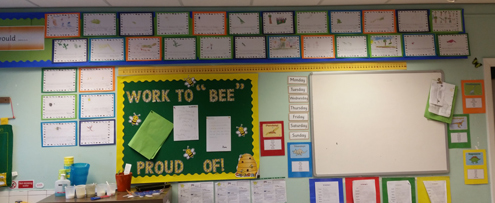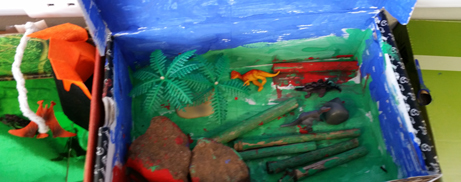Oakdene Primary School Year 2 Discuss Dinosaurs as Pets
Would a dinosaur make a good pet? That was the question addressed this half-term by Year 2 pupils at Oakdene Primary School (Rainhill). Teacher, Miss Barlow, had prepared an enriching and challenging scheme of work for the children and with the aid of Mrs Cross (Learning Assistant) and Miss Waine (Learning Support Assistant), the budding young palaeontologists had been discovering what resources animals need in order to survive as well as developing an understanding of simple food chains. Lots of non-fiction writing exercises had been incorporated into the lesson plans, and the children had been busy writing statements about dinosaurs, facts about these prehistoric animals that they had found out through their own independent research.
Everything Dinosaur School Visit
Lots of Facts About Dinosaurs on Display
Picture credit: Oakdene Primary School/Everything Dinosaur
Would a Dinosaur Make a Good Pet?
Would a dinosaur make a good pet? This was the “challenge question” set for the class. One of the aims of this term is to help the Year 2 children gain more confidence with reading. Various stories and non-fiction books had been read by the children as they explored whether or not a dinosaur would be a good pet.
A dinosaur workshop delivered by one of the fossil experts at Everything Dinosaur certainly helped, as the children learned that although the likes of Tyrannosaurus rex and Triceratops were most certainly a bad idea when it came to pet selection, some types of dinosaur, especially the small, feathery, fast-running ones that were a little smarter might actually make quite a good pet. We discussed what it would be like to have a pet Velociraptor visit the school. Could you train a Velociraptor to catch a ball?
Learning About Dinosaurs
Shoe Box Dinosaur Worlds – Linked to Habitats
Picture credit: Oakdene Primary School/Everything Dinosaur
Year Two Pupils Learning About Dinosaurs
The Year 2 pupils were challenged to create a suitable habitat for a dinosaur, using shoe boxes and other small containers the children created mini dinosaur worlds. Water, plants to eat, other dinosaurs to hunt and places to hide were all included. Clearly the children had thought carefully about the resources an animal needs to survive.
After a morning of dinosaur themed activities we left the children with a couple of extension activities, one of which involved measuring just how big Ankylosaurus and T. rex actually were using toilet rolls instead of rulers. This exercise will help encourage the children to work in small groups and to develop their problem solving skills. We also gave the class one of our “pinkie palaeontologist challenges”, could they design their very own dinosaur?
New Fossil Discoveries
With a new dinosaur being named and described every two to three weeks or so, there are certainly a lot of different types of dinosaur now known to inspire them.
Visit Everything Dinosaur’s website: Everything Dinosaur.
The dinosaur footprint exercise and the subsequent extension activity should help the children gain more confidence in using numbers. One of the key teaching aims this term is to help the children explore numbers further, building on the Year 1 curriculum but this time placing a greater emphasis on the value of numbers. Comparing hands to the feet of dinosaurs and using measuring cubes to work out the difference is a useful activity and should provide plenty of opportunity for the children to gain more confidence when using simple arithmetic.
To see the range of dinosaur toys and games available from Everything Dinosaur: Dinosaur Toys and Gifts.



